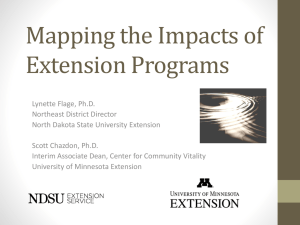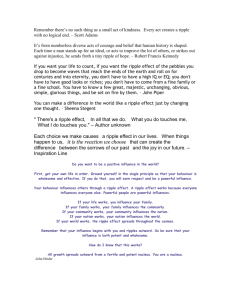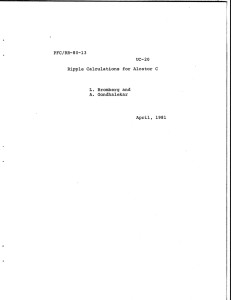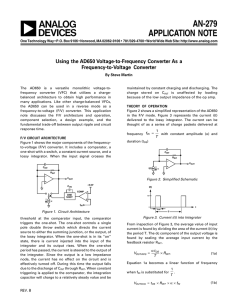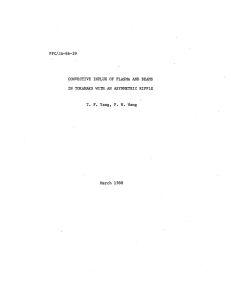How to Make it Happen
advertisement
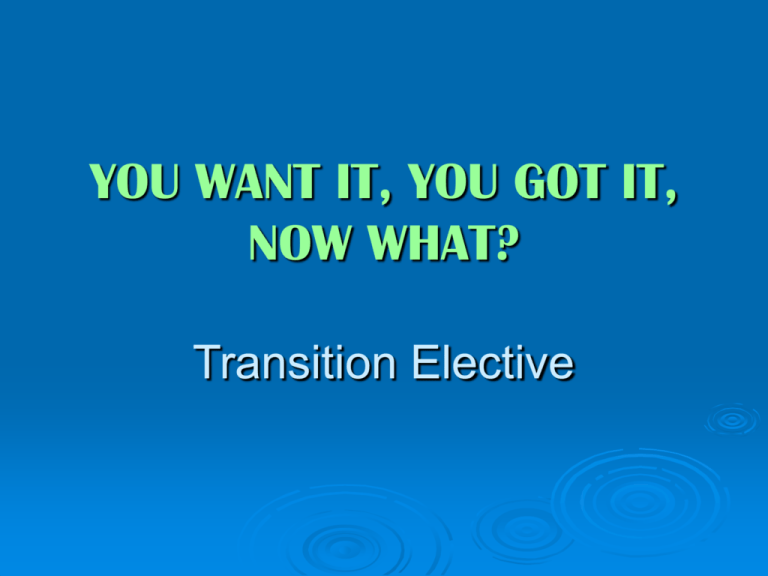
YOU WANT IT, YOU GOT IT, NOW WHAT? Transition Elective Ripple Effect The Ripple Effect is a shift in perspective that leads to greater connections, better business and stronger community. Just like stones thrown into a pond, simple actions create ripples in the lives of all the people you touch and sometimes people you have never even met. Now is the time to make a real difference in your life, workplace or world. Begin to maximize the power of your connections and relationships today, and start to Ripple! The Ripple Effect Start Your Ripple: Make it Happen Identify Your Advocates Co-workers Parents Administrators Community Partners Identify Team Brainstorm Get your nuts and bolts in order How to Make it Happen Write a Proposal Advocates Site Principal Special Education Director Cabinet Level Administrators School Board Making it Happen Writing the Proposal Background: show that a problem exists that needs to be solved • Explain the situation • Explain the general problem (this relates to the ultimate goal) • Show what created the problem • Show that the problem or the situation is important Scope: identifies and describes all work necessary to produce the final product Deliverables: what will be delivered to students and district Personnel: staff and students involved Timetable Fees Equipment, outside contractors, other expenses Active Verbs Making it Happen Support your proposal with a grant Space Salary Staff Equipment Curriculum Investigation and data collection Partner with outside agency Making it Happen When writing your grant consider Matching your project with an appropriate funding supporter Follow application guidelines explicitly Customize proposals for a targeted funder Condense with rich detail Respect the expertise of the foundation Recycle your proposal text Making it Happen Stimulus Money http://sde.state.ok.us/Finance/Recovery/default.html Grant Sources http://www.ed.gov/programs/specedtransition/index.ht ml http://ies.ed.gov/funding/ncser_progs.asp http://sde.state.ok.us/Finance/Grants/default.html http://sde.state.ok.us/Curriculum/SpecEd/Secondary_G rants.html Making it Happen Accountability Pass Standards • • • • • Technology Education Standards Instructional Technology Standards Information Literacy Standards Personal Financial Literacy Standards Social Studies Literacy Standards Civics, Economics, and Government Making It Happen Class Synopsis Scope and Sequence A summary of goals and objectives a curriculum plan, usually in chart form, in which a range of instructional objectives, skills, etc., is organized according to the successive levels at which they are taught Curriculum Map the enduring understandings and overarching goals the standards-based essential skills and concepts the methods of assessment that the teacher and students will be working on throughout the year (e.g., major assignments, projects, performances) the major content resources Curriculum Mapping Recommended – Standards as defined by experts in their field. Written – State standards, local goals and objectives (i.e., curriculum binders). Supported – Curriculum for which materials are actually available, such as textbooks and software. Curriculum Mapping Tested – What is actually assessed at the state and local level. Taught – The content that teachers actually deliver. Learned – The content that students learn. Power Point on Curriculum Mapping http://www.sd104.s-cook.k12.il.us/ppt/cm-overview-bd.ppt#1 Sample Curriculum Map Essential Questions August September October November December Content Skills Assessment Activities You’ve Got It, Now What? Curriculum Free Stuff! • • • • • • LCCE, • Contact OU Zarrow Center for Learning Enrichment My Future, My Plan • Contact OU Zarrow Center for Learning Enrichment Student-directed Transition Planning Lessons • http://www.cec.sped.org/Content/NavigationMenu/ProfessionalDevelopment/ProfessionalTraining/LCC E/LCCE_what.htm Me! • http://www.ncwd-youth.info/assets/guides/411/411_Disability_Disclosure_complete.pdf http://www.familyvillage.wisc.edu/sp/trans.html#career http://www.nichcy.org/InformationResources/Documents/NICHCY%20PUBS/st1.pdf http://www.okcareertech.org/cac/Pages/resources_products/Career_Activity_files/11756CarActFile.pdf http://education.ou.edu/zarrow/?rd=1 http://www.khake.com/index.html available from the NEA Professional Library – http://store.nea.org view samples at http://www.stateart.com/works.php?workId=47&i=2 TECH-Now • Contact Rick DeRennaux @ DeRennaux@-hotmail.com. Or vist the site www.tech-now.biz Support Your Curriculum Transition Activities http://www.ihdi.uky.edu/ktcp/materials/download%20version.ppt#1 http://www.postitt.org/activities/index04.shtml#04 www.spannj.org/transition/TransitionCD/.../transition/Sample%20Strategies.doc www.wsti.org/documents/.../TransitionActivitiesforInstruction.doc Assessments OU Zarrow Center • OKCIS – through Career Tech Casey Life Skills – free on-line tool Career Interest Inventory – available free on-line Personality • • • • Offers four free self-determination assessments http://www.udallas.edu/careers/assessments.cfm http://www.soicc.state.nc.us/soicc/planning/self_assess_tools.htm http://www.nycareerzone.org/graphic/assessment/index.jsp http://www.mnsu.edu/cdc/students/undeclared/handbook/interests.pdf Learning Styles • • http://www.learning-styles-online.com/inventory/Memletics-Learning-Styles-Inventory.pdf http://www.ulc.arizona.edu/online_materials/ls1assess.pdf scoring - http://www.ulc.arizona.edu/online_materials/ls1score.pdf I.D.E.A. Requirements According to IDEA Section 300.29— (a) Transition services means a coordinated set of activities for a student with a disability that (1) Is designed within an outcome-oriented process, that promotes movement from school to post-school activities, including post-secondary education, vocational training, integrated employment (including supported employment), continuing and adult education, adult services, independent living, or community participation; (2) Is based on the individual student's needs, taking into account the student's preferences and interests; and (3) Includes• (i) Instruction; (ii) Related services; (iii) Community experiences; (iv) The development of employment and other post-school adult living objectives; and (v) If appropriate, acquisition of daily living skills and functional vocational evaluation. (b) Transition services for students with disabilities may be special education, if provided as specially designed instruction, or related services, if required to assist a student with a disability to benefit from special education.. " Resources http://www.nsttac.org/ www.ou.edu/zarrow http://www.nichcy.org/EducateChildren/transition_adulthood/pages/s tudents.aspx http://sde.state.ok.us/Curriculum/SpecEd/Secondary_Transition.html http://www.breitlinks.com/careers/career_activities.htm http://www.khake.com/page95.html http://home.swbell.net/jraneri/index.html http://www.ahead.org/students-parents/transitions http://www.dcdt.org/transitionresources.cfm http://www.wtb.wa.gov/documents/2008-10careerguidewebview.pdf http://www.ncwd-youth.info/topic http://www.postitt.org/ Transition Elective Questions ~ Discussion “Far and away the best prize that life has to offer is the chance to work hard at work worth doing.” Theodore Roosevelt Go Forth, Start Your Ripple…


